UAV-Based Yield Prediction Based on LAI Estimation in Winter Wheat (Triticum aestivum L.) Under Different Nitrogen Fertilizer Types and Rates
Abstract
1. Introduction
2. Materials and Methods
2.1. Experimental Site Description
2.2. Experimental Design and Measurements
2.3. Data Collaection
2.3.1. UAV-Based Data Collection
2.3.2. Field Data Collection
2.4. Vegetation Indices Calculation
2.5. LAI Estimation Using Remotely Sensed Data
2.6. Data Analysis
2.6.1. Machine Learning Method
2.6.2. Model Verification
2.6.3. Statistical Analysis
3. Results
3.1. Grain Yield and LAI of Winter Wheat at Different Growth Stages
3.2. Yield Evaluation by LAI of Winter Wheat
3.2.1. Yield Evaluation by LAI at Different Growth Stages
3.2.2. Yield Estimation Based on LAI of Winter Wheat at the Anthesis Stage
3.3. LAI at the Anthesis Stage Estimation Using Remotely Sensed Data
3.3.1. LAI vs. Different Remotely Sensed Data Relationship for Winter Wheat
3.3.2. LAI vs. CIrededge Relationship for Winter Wheat
3.4. Yield Estimation Based on CIred edge of Winter Wheat
3.5. Construction and Comparison of Winter Wheat Grain Yield Prediction Models
3.6. Comparison Between Winter Wheat Grain Yield Were Predicted Based on Spectral Index of CIred edge and Measured Grain Yield
4. Discussion
4.1. The Relationship Between LAI and Grain Yield of Winter Wheat Under Different N Fertilizer Types and Rates
4.2. Response of Vegetation Indexes Calculated from UAV-Based Images to LAI During Anthesis Stage Under Different N Application Types and Amounts
4.3. Prediction of Winter Wheat Grain Yield Using Vegetation Index Based on Different Mechanical Learning Methods
5. Conclusions
Supplementary Materials
Author Contributions
Funding
Data Availability Statement
Conflicts of Interest
References
- Zhai, W.G.; Cheng, Q.; Duan, F.Y.; Huang, X.Q.; Chen, Z. Remote sensing-based analysis of yield and water-fertilizer use efficiency in winter wheat management. Agric. Water Manag. 2025, 311, 109390. [Google Scholar] [CrossRef]
- Food and Agriculture Organization of the United Nations. Agriculture Database; FAOSTAT: Rome, Italy, 2023; Available online: http://www.fao.org/faostat/en/#data/QC (accessed on 30 May 2025).
- Zhang, Y.; Hui, J.; Qin, Q.M.; Sun, Y.H.; Zhang, T.Y.; Sun, H.; Li, M.Z. Transfer-Learning-Based approach for leaf chlorophyll content estimation of winter wheat from hyperspectral data. Remote Sens. Environ. 2021, 267, 112724. [Google Scholar] [CrossRef]
- Tian, Z.Z.; Zhang, Y.; Liu, K.D.; Li, Z.H.; Lin, M.Z.; Zhang, H.Y.; Wu, J.M. UAV remote sensing prediction method of winter wheat yield based on the fused features of crop and soil. Remote Sens. 2022, 14, 5054. [Google Scholar] [CrossRef]
- Liu, F.; Jiang, X.T.; Wu, Z.Y. Attention mechanism-combined LSTM for grain yield prediction in China using multi-source satellite imagery. Sustainability 2023, 15, 9210. [Google Scholar] [CrossRef]
- Li, G.H.; Cheng, G.G.; Lu, W.P.; Lu, D.L. Differences of yield and nitrogen use efficiency under different applications of slow release fertilizer in spring maize. J. Integr. Agric. 2021, 20, 554–564. [Google Scholar] [CrossRef]
- Wang, X.; Xiang, Y.Z.; Guo, J.J.; Tang, Z.J.; Zhao, S.T.; Wang, H.; Li, Z.J.; Zhang, F.C. Coupling effect analysis of drip irrigation and mixed slow-release nitrogen fertilizer on yield and physiological characteristics of winter wheat in Guanzhong area. Field Crops Res. 2023, 302, 109103. [Google Scholar] [CrossRef]
- Chang, Y.L.; Liu, J.M.; Li, Y.H.; Sun, B.H.; Zhang, S.L.; Yang, X.Y. Investigation and evaluation of fertilization under winter wheat and summer maize rotation system in Guanzhong Plain, Shaanxi Province. J. Northwest AF Univ. (Nat. Sci. Ed.) 2014, 42, 51–61. (In Chinese) [Google Scholar]
- Guo, J.J.; Fan, J.L.; Zhang, F.C.; Yan, S.C.; Zheng, J.; Wu, Y.; Li, J.; Wang, Y.L.; Sun, X.; Liu, X.Q.; et al. Blending urea and slow-release nitrogen fertilizer increases dryland maize yield and nitrogen use efficiency while mitigating ammonia volatilization. Sci. Total Environ. 2021, 790, 148058. [Google Scholar] [CrossRef]
- Shi, J.C.; Yasuor, H.; Yermiyahu, U.; Zuo, Q.; Ben-Gal, A. Dynamic responses of wheat to drought and nitrogen stresses during re-watering cycles. Agric. Water Manag. 2014, 146, 163–172. [Google Scholar] [CrossRef]
- Li, C.L.; Cao, Y.Q.; Wang, Y.; Li, X.Y.; Li, Y.X.; Zhu, L.; Zhao, X.H.; Gao, Q. Effects of mixed controlled release and normal urea on maize (Zea mays L.) growth, grain yield and nitrogen balance and use efficiency in northeast China. Appl. Ecol. Environ. Res. 2020, 18, 5367–5382. [Google Scholar] [CrossRef]
- Zhang, G.; Liu, S.; Wang, X.Y.; Wang, X.F.; Zhang, Y.; Zhao, D.; Wen, X.; Han, J.; Liao, Y. Mixed application of controlled-release urea and normal urea can improve crop productivity and reduce the carbon footprint under straw return in winter wheat-summer maize cropping system. Eur. J. Agron. 2023, 151, 127002. [Google Scholar] [CrossRef]
- Andrade, A.B.; Guelfi, D.R.; Chagas, W.F.T.; Cancellier, E.L.; De Souza, T.L.; Oliveira, L.S.S.; Faquin, V.; Du, C.W. Fertilizing maize croppings with blends of slow/controlled release and conventional nitrogen fertilizers. J. Plant Nutr. Soil Sci. 2021, 184, 227–237. [Google Scholar] [CrossRef]
- Guo, J.J.; Fan, J.L.; Xiang, Y.Z.; Zhang, F.C.; Yan, S.C.; Zhang, X.Y.; Zheng, J.; Hou, X.H.; Tang, Z.J.; Li, Z.J. Maize leaf functional responses to blending urea and slow-release nitrogen fertilizer under various drip irrigation regimes. Agric. Water Manag. 2022, 262, 107396. [Google Scholar] [CrossRef]
- Li, Y.B.; Song, H.; Zhou, L.; Xua, Z.Z.; Zhou, G.S. Vertical distributions of chlorophyll and nitrogen and their associations with photosynthesis under drought and rewatering regimes in a maize field. Agric. Meteorol. 2019, 272–273, 40–54. [Google Scholar] [CrossRef]
- Li, G.H.; Zhao, B.; Dong, S.T.; Zhang, J.W.; Liu, P.; Lu, W.P. Controlled-release urea combining with optimal irrigation improved grain yield, nitrogen uptake, and growth of maize. Agric. Water Manag. 2020, 227, 105834. [Google Scholar] [CrossRef]
- Tian, X.F.; Li, C.L.; Zhang, M.; Li, T.; Lu, Y.Y.; Liu, L.F. Controlled release urea improved crop yields and mitigated nitrate leaching under cotton-garlic intercropping system in a 4-year field trial. Soil Till. Res. 2018, 175, 158–167. [Google Scholar] [CrossRef]
- Qu, Z.M.; Qi, X.C.; Shi, R.G.; Zhao, Y.J.; Hu, Z.P.; Chen, Q.; Li, C.L. Reduced N fertilizer application with optimal blend of controlled-release urea and urea improves tomato yield and quality in greenhouse production system. J. Soil Sci. Plant Nutr. 2020, 20, 1741–1750. [Google Scholar] [CrossRef]
- Peng, Y.; Zhu, T.; Li, Y.C.; Dai, C.; Fang, S.H.; Gong, Y.; Wu, X.T.; Zhu, R.S.; Liu, K. Remote prediction of yield based on LAI estimation in oilseed rape under different planting methods and nitrogen fertilizer applications. Agric. Forest. Meteorol. 2019, 271, 116–125. [Google Scholar] [CrossRef]
- Wan, L.; Cen, H.Y.; Zhu, J.P.; Zhang, J.F.; Zhu, Y.M.; Sun, D.W.; Du, X.Y.; Zhai, L.; Weng, H.Y.; Li, Y.J.; et al. Grain yield prediction of rice using multi-temporal UAV-based RGB and multispectral images and model transfer-a case study of small farmlands in the South of China. Agric. For. Meteorol. 2020, 291, 108096. [Google Scholar] [CrossRef]
- Maes, W.H.; Steppe, K. Perspectives for remote sensing with unmanned aerial vehicles in precision agriculture. Trends Plant Sci. 2019, 24, 152–164. [Google Scholar] [CrossRef]
- Zhang, H.D.; Wang, L.Q.; Tian, T.; Yin, J.H. A review of unmanned aerial vehicle low-altitude remote sensing (uav-lars) use in agricultural monitoring in China. Remote Sens. 2021, 13, 1221. [Google Scholar] [CrossRef]
- Zhou, W.Q.; Song, C.; Liu, C.L.; Fu, Q.; An, T.H.; Wang, Y.J.; Sun, X.B.; Wen, N.; Tang, H.; Wang, Q. A prediction model of maize field yield based on the fusion of multitemporal and multimodal UAV data: A case study in Northeast China. Remote Sens. 2023, 15, 3483. [Google Scholar] [CrossRef]
- Li, D.; Miao, Y.X.; Gupta, S.K.; Rosen, C.J.; Yuan, F.; Wang, C.Y.; Wang, L.; Huang, Y.B. Improving potato yield prediction by combining cultivar information and UAV remote sensing data using machine learning. Remote Sens. 2021, 13, 3322. [Google Scholar] [CrossRef]
- Yang, B.; Zhu, W.X.; Rezaei, E.E.; Li, J.; Sun, Z.G.; Zhang, J.Q. The optimal phenological phase of maize for yield prediction with high-frequency UAV remote sensing. Remote Sens. 2022, 14, 1559. [Google Scholar] [CrossRef]
- Toledo, C.A.; Crawford, M. Deep learning models using multi-modal remote sensing for prediction of maize yield in plant breeding experiments. In Proceedings of the IGARSS 2023—2023 IEEE International Geoscience and Remote Sensing Symposium, Pasadena, CA, USA, 16–21 July 2023; pp. 487–490. [Google Scholar]
- Zhou, X.; Zheng, H.B.; Xu, X.Q.; He, J.Y.; Ge, X.K.; Yao, X.; Cheng, T.; Zhu, Y.; Cao, W.X.; Tian, Y.C. Predicting grain yield in rice using multi-temporal vegetation indices from UAV-based multispectral and digital imagery. ISPRS J. Photogramm. Remote Sens. 2017, 130, 246–255. [Google Scholar] [CrossRef]
- Tilly, N.; Aasen, H.; Bareth, G. Fusion of plant height and vegetation indices for the estimation of barley biomass. Remote Sens. 2015, 7, 11449–11480. [Google Scholar] [CrossRef]
- Lu, J.S.; Cheng, D.L.; Geng, C.M.; Zhang, Z.T.; Xiang, Y.Z.; Hu, T.T. Combining plant height, canopy coverage and vegetation index from UAV-based RGB images to estimate leaf nitrogen concentration of summer maize. Biosyst. Eng. 2021, 202, 42–54. [Google Scholar] [CrossRef]
- Khanal, S.; Fulton, J.; Klopfenstein, A.; Douridas, N.; Shearer, S. Integration of high resolution remotely sensed data and machine learning techniques for spatial prediction of soil properties and corn yield. Comput. Electron. Agric. 2018, 153, 213–225. [Google Scholar] [CrossRef]
- Van Klompenburg, T.; Kassahun, A.; Catal, C. Crop yield prediction using machine learning: A systematic literature review. Comput. Electron. Agric. 2020, 177, 105709. [Google Scholar] [CrossRef]
- Zhou, X.B.; Kono, Y.; Win, A.; Matsui, T.; Tanaka, T.S.T. Predicting within-field variability in grain yield and protein content of winter wheat using UAV-based multispectral imagery and machine learning approaches. Plant Prod. Sci. 2021, 24, 137–151. [Google Scholar] [CrossRef]
- Liu, H.Y.; Zhu, H.C.; Wang, P. Quantitative modeling for leaf nitrogen content of winter wheat using UAV-based hyperspectral data. Int. J. Remote Sens. 2017, 38, 2117–2134. [Google Scholar] [CrossRef]
- Islam, M.D.; Di, L.P.; Qamer, F.M.; Shrestha, S.; Guo, L.Y.; Lin, L.; Mayer, T.J.; Phalke, A.R. Rapid rice yield estimation using integrated remote sensing and meteorological data and machine learning. Remote Sens. 2023, 15, 2374. [Google Scholar] [CrossRef]
- Zhang, S.H.; Wang, H.D.; Sun, X.; Fan, J.L.; Zhang, F.C.; Zheng, J.; Li, Y.P. Effects of farming practices on yield and crop water productivity of wheat, maize and potato in China: A meta-analysis. Agric. Water Manag. 2021, 243, 106444. [Google Scholar] [CrossRef]
- Zhou, Y.C.; Lao, C.C.; Yang, Y.L.; Zhang, Z.T.; Chen, H.Y.; Chen, Y.W.; Chen, J.Y.; Ning, J.F.; Yang, N. Diagnosis of winter-wheat water stress based on UAV-borne multispectral image texture and vegetation indices. Agric. Water Manag. 2021, 256, 107076. [Google Scholar] [CrossRef]
- Rouse, J.W. Monitoring Vegetation Systems in the Great Plains with ERTS; NASA Special Publications; NASA: Washington, DC, USA, 1974; pp. 309–317. [Google Scholar]
- Rondeaux, G.; Steven, M.; Baret, F. Optimization of soil-adjusted vegetation indices. Remote Sens. Environ. 1996, 55, 95–107. [Google Scholar] [CrossRef]
- Jiang, Z.; Huete, A.R.; Didan, K.; Miura, T. Development of a two-band enhanced vegetation index without a blue band. Remote Sens. Environ. 2008, 112, 3833–3845. [Google Scholar] [CrossRef]
- Gitelson, A.A.; Gritz, Y.; Merzlyak, M.N. Relationships between leaf chlorophyll content and spectral reflectance and algorithms for non-destructive chlorophyll assessment in higher plant leaves. J. Plant. Physiol. 2003, 160, 271–282. [Google Scholar] [CrossRef] [PubMed]
- Dash, J.; Curran, P.J. The MERIS terrestrial chlorophyll index. Int. J. Remote Sens. 2004, 25, 5403–5413. [Google Scholar] [CrossRef]
- Gitelson, A.A.; Merzlyak, M. Remote estimation of chlorophyll content in higher plant leaves. Int. J. Remote Sens. 1997, 18, 291–298. [Google Scholar] [CrossRef]
- Vina, A.; Gitelson, A.A. New developments in the remote estimation of the fraction of absorbed photosynthetically active radiation in crops. Geophys. Res. Lett. 2005, 32, L17403. [Google Scholar] [CrossRef]
- Duan, J.Z.; Shao, Y.H.; He, L.; Li, X.; Hou, G.; Li, S.N.; Feng, W.; Zhu, Y.J.; Wang, Y.H.; Xie, Y.X. Optimizing nitrogen management to achieve high yield, high nitrogen efficiency and low nitrogen emission in winter wheat. Sci. Total Environ. 2019, 697, 134088. [Google Scholar] [CrossRef]
- Shi, W.X.; Zhang, Q.; Xie, R.H.S.; Tan, K.; Wang, J.F.; Lun, Y. Blending loss-control and normal urea maximizes nitrogen utilization of summer maize by mitigating ammonia volatilization and nitrate leaching. Plant Soil 2023, 490, 125–141. [Google Scholar] [CrossRef]
- Zhang, Y.Q.; Wang, J.D.; Gong, S.H.; Xu, D.; Sui, J. Nitrogen fertigation effect on photosynthesis, grain yield and water use efficiency of winter wheat. Agric. Water Manag. 2017, 179, 227–287. [Google Scholar] [CrossRef]
- Fan, Z.; Chen, J.X.; Zhai, S.; Ding, X.H.; Zhang, H.Z.; Sun, S.C.; Tian, X.F. Optimal blends of controlled-release urea and conventional urea improved nitrogen use efficiency in wheat and maize with reduced nitrogen application. J. Soil Sci. Plant Nutr. 2021, 21, 1103–1111. [Google Scholar] [CrossRef]
- Ma, Q.; Wang, M.Y.; Zheng, G.L.; Yao, Y.; Tao, R.R.; Zhu, M.; Ding, J.F.; Li, C.Y.; Guo, W.S.; Zhu, X.K. Twice-split application of controlled-release nitrogen fertilizer met the nitrogen demand of winter wheat. Field Crops Res. 2021, 267, 108163. [Google Scholar] [CrossRef]
- Maresma, Á.; Ariza, M.; Martínez, E.; Lloveras, J.; Martinez-Casasnovas, J.A. Analysis of vegetation indices to determine nitrogen application and yield prediction in maize (Zea mays L.) from a standard UAV service. Remote Sens. 2016, 8, 973. [Google Scholar] [CrossRef]
- Hikosaka, K.; Anten, N.P.; Borjigidai, A.; Kamiyama, C.; Sakai, H.; Hasegawa, T.; Oikawa, S.; Lio, A.; Watanabe, M.; Koike, T.; et al. A meta-analysis of leaf nitrogen distribution within plant canopies. Ann. Bot. 2016, 118, 239–247. [Google Scholar] [CrossRef]
- Luca, V.; Paul, D.T.; Guido, D.; Vincenzo, M. The response of ecosystem carbon fluxes to LAI and environmental drivers in a maize crop grown in two contrasting seasons. Int. J. Biometeorol. 2016, 60, 411–420. [Google Scholar]
- Huang, J.X.; Tian, L.Y.; Liang, S.L.; Ma, H.Y.; Becker-Reshef, I.; Huang, Y.B.; Su, W.; Zhang, X.D.; Zhu, D.H.; Wu, W.B. Improving winter wheat yield estimation by assimilation of the leaf area index from Landsat TM and MODIS data into the WOFOST model. Agric. For. Meteorol. 2015, 204, 106–121. [Google Scholar] [CrossRef]
- Du, M.M.; Noguchi, N. Monitoring of wheat growth status and mapping of wheat yield’s within-field spatial variations using color images acquired from UAV-camera system. Remote Sens. 2017, 9, 289. [Google Scholar] [CrossRef]
- Zheng, H.B.; Cheng, T.; Zhou, M.; Li, D.; Yao, X.; Tian, Y.C.; Cao, W.X.; Zhu, Y. Improved estimation of rice aboveground biomass combining textural and spectral analysis of UAV imagery. Precis. Agric. 2019, 20, 611–629. [Google Scholar] [CrossRef]
- Muruganantham, P.; Wibowo, S.; Grandhi, S.; Samrat, N.H.; Islam, N. A systematic literature review on crop yield prediction with deep learning and remote sensing. Remote Sens. 2022, 14, 1990. [Google Scholar] [CrossRef]
- Zhang, Y.; Qin, Q.M.; Ren, H.Z.; Sun, Y.H.; Li, M.Z.; Zhang, T.Y.; Ren, S.L. Optimal hyperspectral characteristics determination for winter wheat yield prediction. Remote Sens. 2018, 10, 2015. [Google Scholar] [CrossRef]
- Bian, C.F.; Shi, H.T.; Wu, S.Q.; Zhang, K.F.; Wei, M.; Zhao, Y.D.; Sun, Y.Q.; Zhuang, H.F.; Zhang, X.W.; Chen, S. Prediction of field-scale wheat yield using machine learning method and multi-spectral UAV data. Remote Sens. 2022, 14, 1474. [Google Scholar] [CrossRef]
- Martins, G.D.; Santos, L.C.S.; Carmo, G.J.D.S.; Neto, O.F.D.S.; Castoldi, R.; Machado, A.I.M.R.; Charlo, H.C.D.O. Multispectral images for estimating morphophysiological and nutritional parameters in cabbage seedlings. Smart Agric. Technol. 2023, 4, 100211. [Google Scholar] [CrossRef]
- Guo, C.L.; Tang, Y.N.; Lu, J.S.; Zhu, Y.; Cao, W.X.; Cheng, T.; Zhang, L.; Tian, Y.C. Predicting wheat productivity: Integrating time series of vegetation indices into crop modeling via sequential assimilation. Agric. Forest. Meteorol. 2019, 272–273, 69–80. [Google Scholar] [CrossRef]
- Psiroukis, V.; Darra, N.; Kasimati, A.; Trojacek, P.; Hasanli, G.; Fountas, S. Development of a multi-scale tomato yield prediction model in azerbaijan using spectral indices from sentinel-2 imagery. Remote Sens. 2022, 14, 4202. [Google Scholar] [CrossRef]
- Yao, X.; Wang, N.; Liu, Y.; Cheng, T.; Tian, Y.C.; Chen, Q.; Zhu, Y. Estimation of wheat LAl at middle to high levels using unmanned aerial vehicle narrow band multispectral imagery. Remote Sens. 2017, 9, 1304. [Google Scholar] [CrossRef]
- Jiang, J.L.; Ji, X.S.; Yao, X.; Tian, Y.C.; Zhu, Y.; Cao, W.X.; Cheng, T. Evaluation of three techniques for correcting the spatial scaling bias of leaf area index. Remote Sens. 2018, 10, 221. [Google Scholar] [CrossRef]
- Liu, X.J.; Ferguson, R.B.; Zheng, H.B.; Tian, Y.C.; Cao, W.X.; Zhu, Y. Using an active-optical sensor to develop an optimal NDVl dynamic model for high-yield rice production (Yangtze, China). Sensors 2017, 17, 672. [Google Scholar] [CrossRef]
- Jeong, S.; Ko, J.; Yeom, J.M. Predicting rice yield at pixel scale through synthetic use of crop and deep learning models with satellite data in South and North Korea. Sci. Total Environ. 2022, 802, 149726. [Google Scholar] [CrossRef]
- Wang, X.L.; Huang, J.X.; Feng, Q.L.; Yin, D.Q. Winter wheat yield prediction at county level and uncertainty analysis in main wheat producing regions of China with deep learning approaches. Remote Sens. 2020, 12, 1744. [Google Scholar] [CrossRef]
- Weiss, M.; Jacob, F.; Duveiller, G. Remote sensing for agricultural applications: A meta-review. Remote Sens. Environ. 2020, 236, 111402. [Google Scholar] [CrossRef]
- Morier, T.; Cambouris, A.N.; Chokmani, K. In-Season nitrogen status assessment and yield estimation using hyperspectral vegetation indices in a potato crop. Agron. J. 2015, 107, 1295–1309. [Google Scholar] [CrossRef]
- Huang, J.X.; Ma, H.Y.; Sedano, F.; Lewis, P.; Liang, S.; Wu, Q.L.; Su, W.; Zhang, X.D.; Zhu, D.H. Evaluation of regional estimates of winter wheat yield by assimilating three remotely sensed reflectance datasets into the coupled WOFOST–PROSAIL model. Eur. J. Agron. 2019, 102, 1–13. [Google Scholar] [CrossRef]
- Liu, F.; Liu, X.N.; Ding, C.; Wu, L. The dynamic simulation of rice growth parameters under cadmium stress with the assimilation of multi-period spectral indices and crop model. Field Crops Res. 2015, 183, 225–234. [Google Scholar] [CrossRef]
- Lin, F.T.; Weng, Y.B.; Chen, H.L.; Zhuang, P.F. Intelligent greenhouse system based on remote sensing images and machine learning promotes the efficiency of agricultural economic growth. Environ. Technol. Innov. 2021, 24, 101758. [Google Scholar] [CrossRef]
- Dang, C.Y.; Liu, Y.; Yue, H.; Qian, J.X.; Zhu, R. Autumn crop yield prediction using data-driven approaches: Support vector machines, random forest, and deep neural network methods. Can. J. Remote Sens. 2020, 47, 162–181. [Google Scholar] [CrossRef]
- Chen, R.Q.; Zhang, C.J.; Xu, B.; Zhu, Y.H.; Zhao, F.; Han, S.Y.; Yang, G.J.; Yang, H. Predicting individual apple tree yield using UAV multi-source remote sensing data and ensemble learning. Comput. Electron. Agric. 2022, 201, 107275. [Google Scholar] [CrossRef]
- Li, R.; Wang, D.L.; Zhu, B.; Liu, T.; Sun, C.M.; Zhang, Z.J. Estimation of nitrogen content in wheat using indices derived from RGB and thermal infrared imaging. Field Crops Res. 2022, 289, 108735. [Google Scholar] [CrossRef]

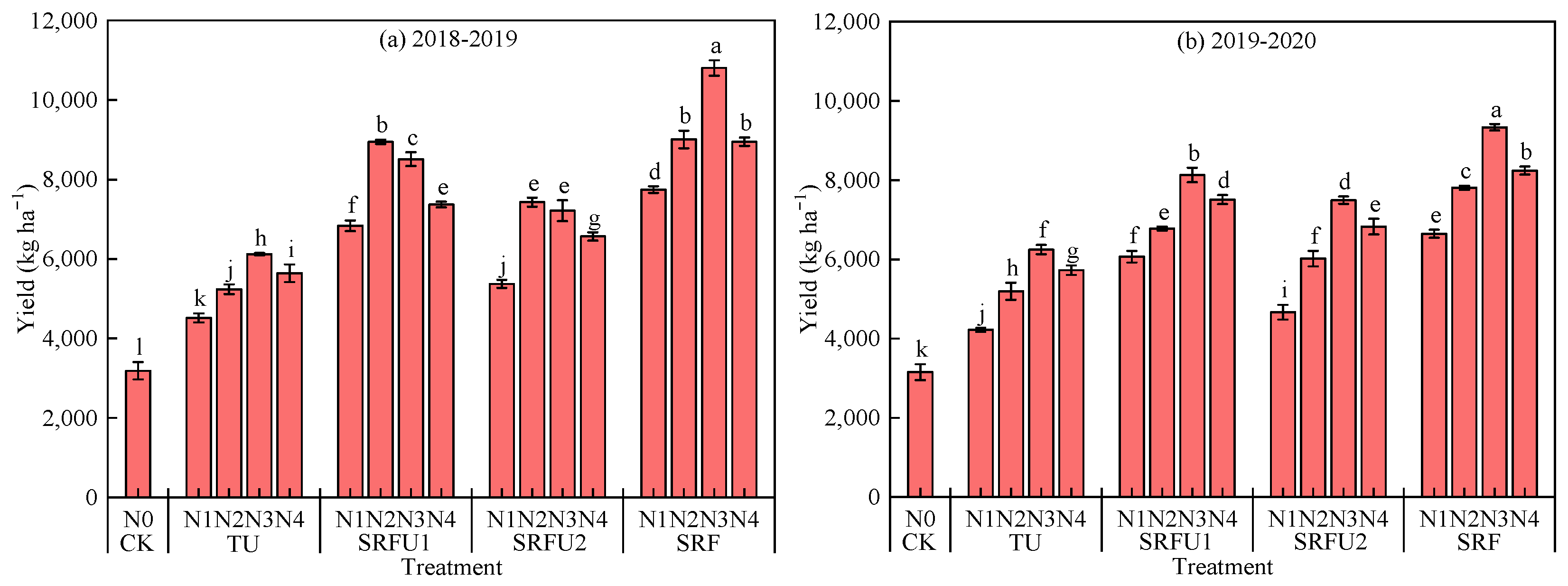
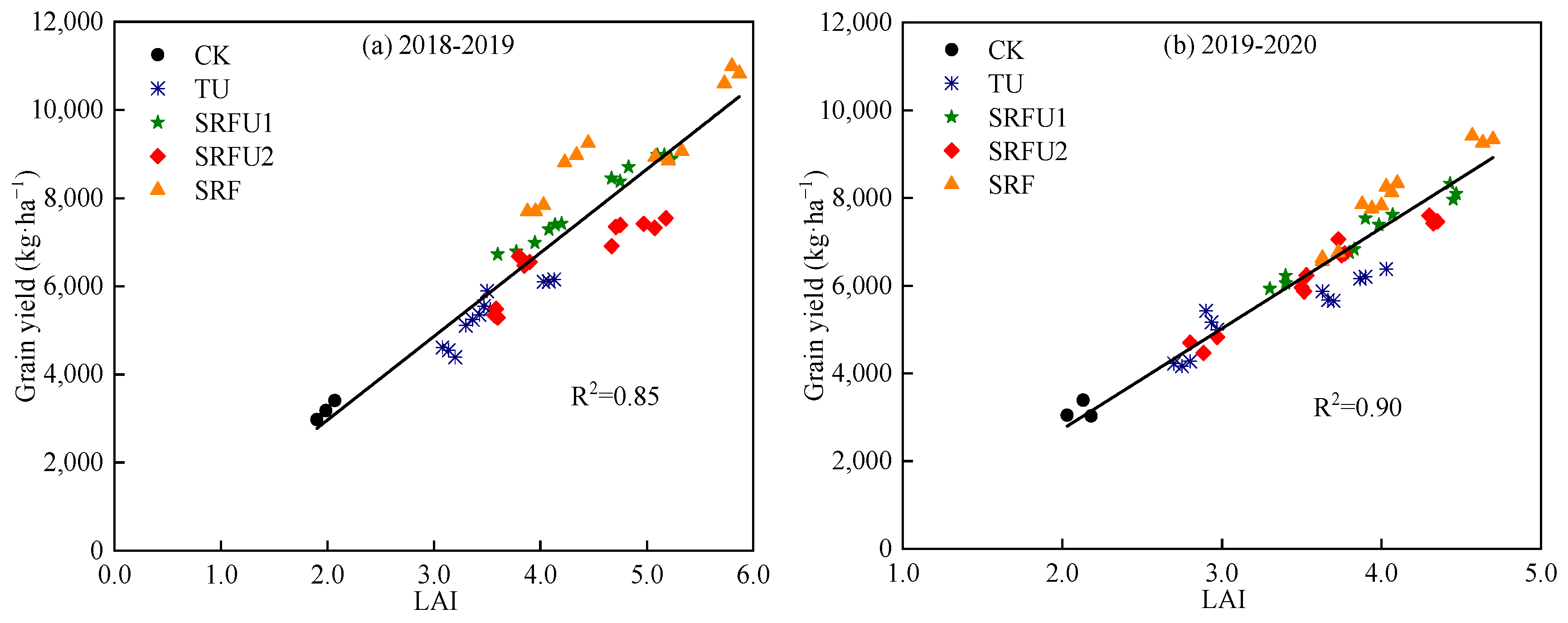


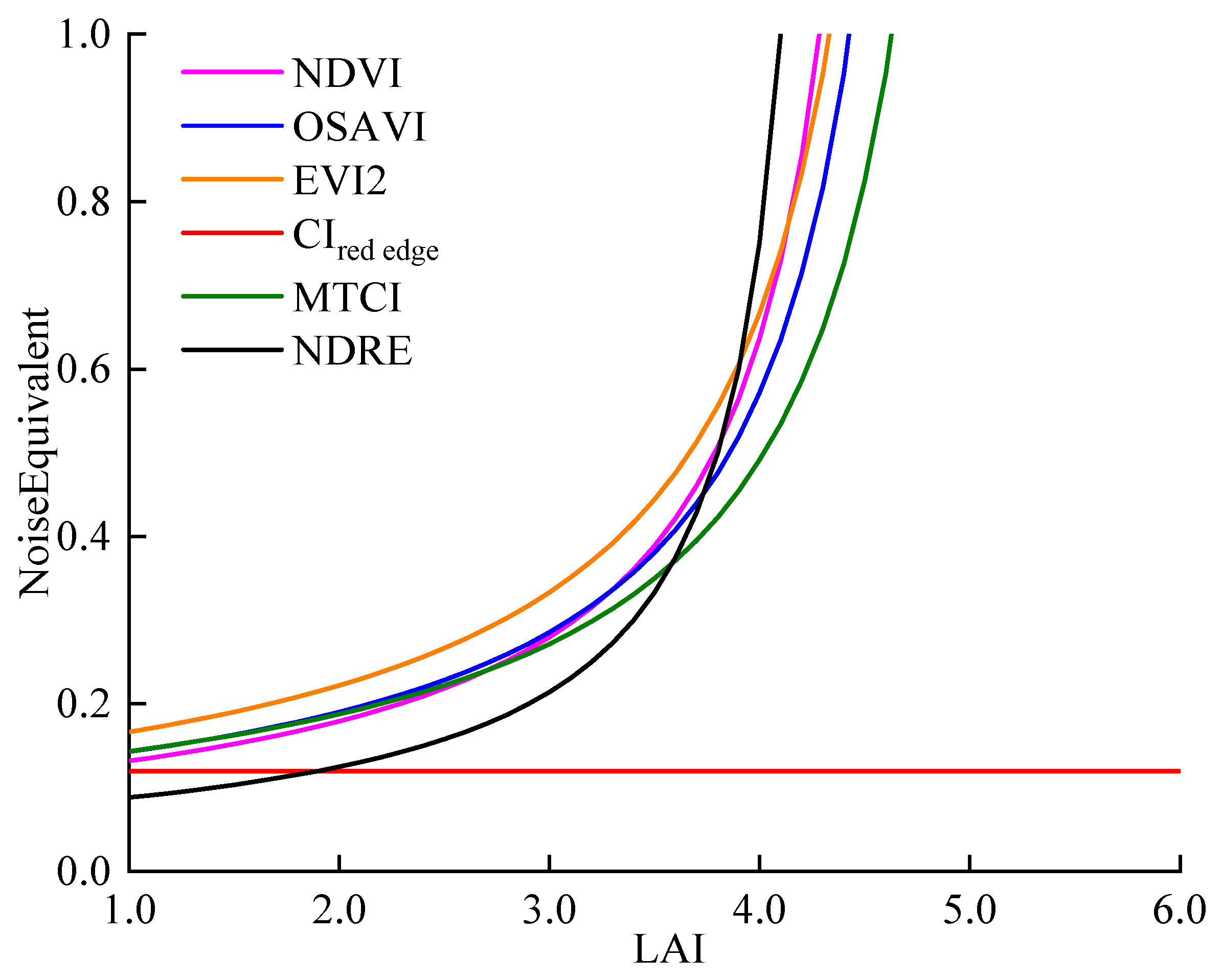

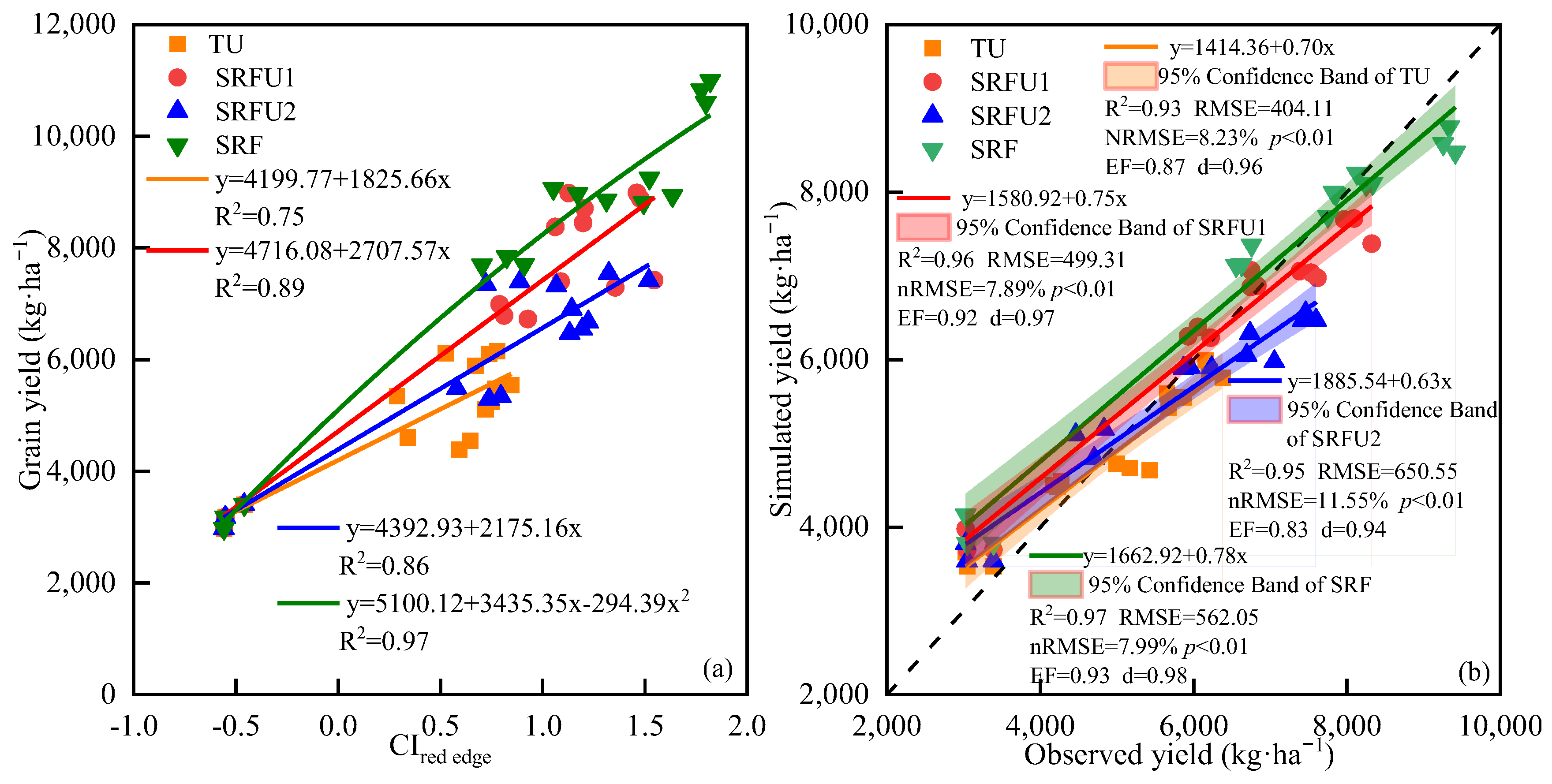
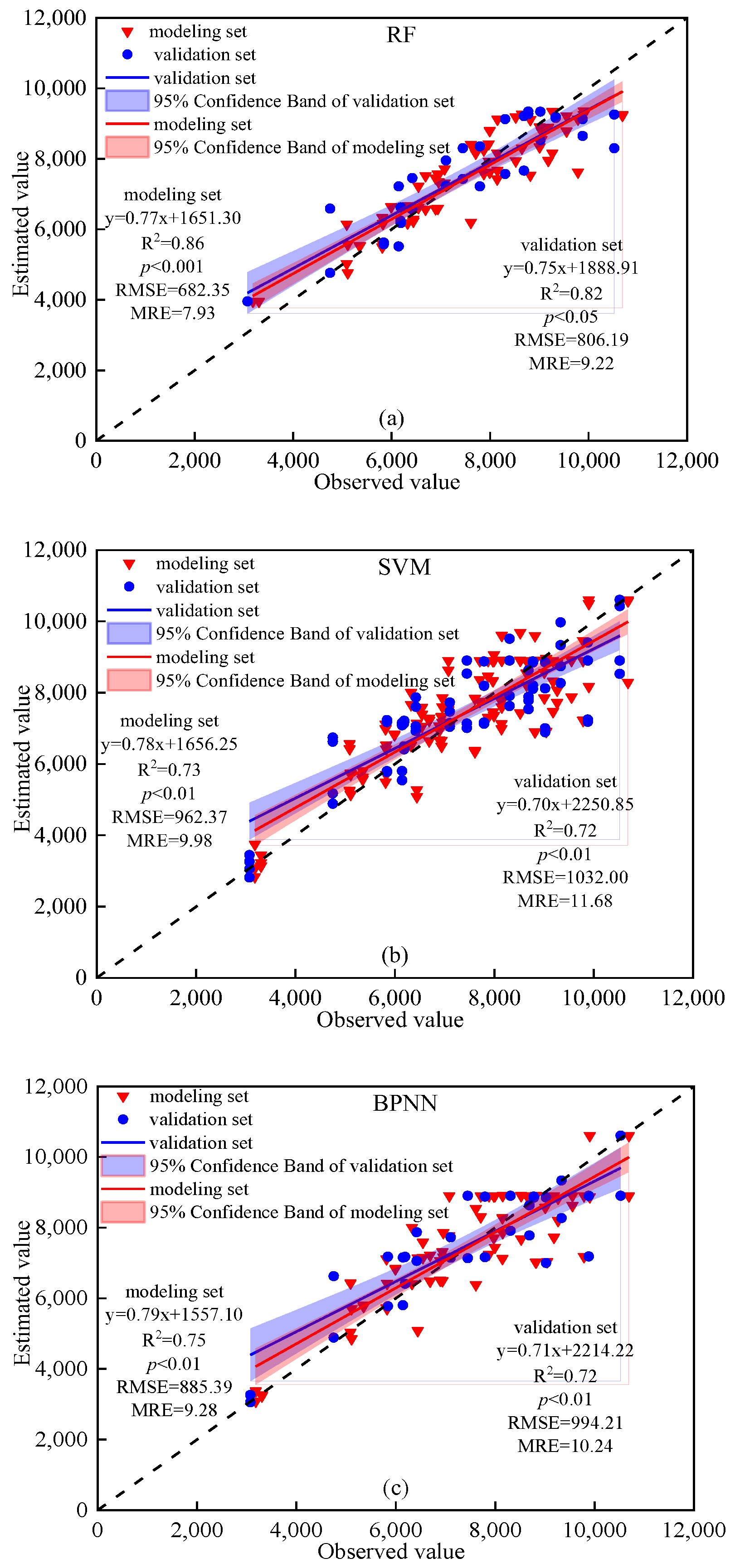

| Published Index | Reference |
|---|---|
| Normalized Difference Vegetation Index (NDVI) = (NIR − Red)/(NIR + Red) | (Rouse et al., 1974) [37] |
| Optimized Soil Adjusted Vegetation Index (OSAVI) = (1 + 0.16) × (NIR − Red)/(NIR + Red + 0.16) | (Rondeaux et al., 1996) [38] |
| (Enhanced Vegetation Index) EVI2 = 2.5 × (NIR − Red)/(NIR + 2.4 × Red + 1) | (Jiang et al., 2008) [39] |
| (Red-Edge Vegetation Index) CIred edge = NIR/Rred edge − 1 | (Gitelson et al., 2003) [40] |
| (MERIS Terrestrial Chlorophyll Index) MTCI = (NIR − Rred edge)/(NIR + Red) | (Dash and Curran et al., 2004) [41] |
| (Normalized Difference Red-Edge Index) NDRE = (NIR − Rred edge)/(NIR + Rred edge) | (Gitelson and Merzlyak et al., 1997) [42] |
| Year | Treatment | Regreening Stage | Jointing Stage | Anthesis Stage | Filling Stage | |
|---|---|---|---|---|---|---|
| 2018–2019 | CK | N0 | 0.56 i | 0.67 j | 0.99 k | 0.37 i |
| TU | N1 | 1.97 efgh | 3.27 defg | 3.14 j | 1.57 h | |
| N2 | 3.42 a | 3.56 bcde | 3.37 ij | 2.05 g | ||
| N3 | 2.46 bcd | 4.03 a | 4.08 ef | 2.74 e | ||
| N4 | 2.31 cde | 3.71 abc | 3.50 i | 2.54 ef | ||
| SRFU1 | N1 | 1.62 h | 2.71 hi | 3.78 gh | 2.69 ef | |
| N2 | 2.11 defg | 3.69 abc | 5.17 b | 4.08 a | ||
| N3 | 2.48 bcd | 3.36 cdefg | 4.75 c | 3.94 ab | ||
| N4 | 2.35 cde | 3.17 efg | 4.14 de | 3.67 bc | ||
| SRFU2 | N1 | 1.78 gh | 2.47 i | 3.59 hi | 2.39 f | |
| N2 | 2.23 cdef | 3.49 cdef | 5.08 b | 3.92 ab | ||
| N3 | 2.52 bc | 3.03 gh | 4.71 c | 3.37 cd | ||
| N4 | 2.40 cd | 2.64 i | 3.85 fg | 3.17 d | ||
| SRF | N1 | 1.87 fgh | 3.11 fg | 3.96 efg | 3.14 d | |
| N2 | 2.83 b | 3.41 cdefg | 4.34 d | 3.43 cd | ||
| N3 | 2.44 cd | 3.90 ab | 5.80 a | 4.22 a | ||
| N4 | 2.20 cdef | 3.64 abcd | 5.21 b | 4.02 a | ||
| N fertilizer type (NT) | ** | ** | ** | ** | ||
| N application rate (NR) | ** | ** | ** | ** | ||
| NR × NT | ** | ** | ** | ** | ||
| 2019–2020 | CK | N0 | 0.67 h | 2.32 l | 2.68 h | 2.13 k |
| TU | N1 | 2.36 ef | 2.53 jk | 2.75 h | 2.27 j | |
| N2 | 2.75 abcd | 2.89 h | 2.94 g | 2.54 h | ||
| N3 | 2.95 ab | 4.23 a | 4.27 c | 3.88 b | ||
| N4 | 2.77 abcd | 3.49 d | 3.67 e | 3.21 e | ||
| SRFU1 | N1 | 1.94 g | 2.44 k | 2.90 g | 2.30 ij | |
| N2 | 2.43 def | 2.61 j | 3.80 e | 2.84 g | ||
| N3 | 2.97 ab | 4.08 b | 4.45 b | 3.90 b | ||
| N4 | 2.82 abc | 3.17 f | 3.99 d | 3.21 e | ||
| SRFU2 | N1 | 2.13 fg | 2.29 l | 2.89 g | 2.22 j | |
| N2 | 2.38 ef | 2.45 k | 3.52 f | 2.61 h | ||
| N3 | 3.02 a | 3.94 c | 4.33 bc | 3.76 c | ||
| N4 | 2.88 abc | 3.04 g | 3.75 e | 3.03 f | ||
| SRF | N1 | 2.09 fg | 2.48 k | 3.03 g | 2.38 i | |
| N2 | 2.54 cde | 2.77 i | 3.94 d | 2.99 f | ||
| N3 | 2.92 ab | 4.18 ab | 4.64 a | 4.04 a | ||
| N4 | 2.63 bcde | 3.33 e | 4.07 d | 3.33 d | ||
| N fertilizer type (NT) | ns | ** | ** | ** | ||
| N application rate (NR) | ** | ** | ** | ** | ||
| NR × NT | ns | ns | ** | ** | ||
| 2018–2019 | 2019–2020 | |||||||
|---|---|---|---|---|---|---|---|---|
| RG | JO | AN | FI | RG | JO | AN | FI | |
| Pearson correlation coefficient (r) | 0.47 | 0.66 | 0.96 | 0.94 | 0.67 | 0.53 | 0.83 | 0.70 |
| Significance analysis | ** | ** | ** | ** | ** | ** | ** | ** |
| Year | N fertilizer Types | Fitting Function | R2 |
|---|---|---|---|
| 2018–2019 | TU | Yield = 261.40 + 1455.88 LAI | 0.95 |
| SRFU1 | Yield = −1976.77 + 2901.34 LAI − 150.79 LAI2 | 0.99 | |
| SRFU2 | Yield = −1268.48 + 2547.84 LAI − 161.14 LAI2 | 0.97 | |
| SRF | Yield = −3287.88 + 3762.64 LAI − 241.50 LAI2 | 0.97 | |
| ALL | Yield = −827.30 + 1896.03 LAI | 0.85 | |
| 2019–2020 | TU | Yield = −3588.13 + 4016.09 LAI − 390.40 LAI2 | 0.94 |
| SRFU1 | Yield = −1338.63 + 2163.98 LAI | 0.99 | |
| SRFU2 | Yield = −1116.09 + 2033.90 LAI | 0.98 | |
| SRF | Yield = −2134.29 + 2489.85 LAI | 0.99 | |
| ALL | Yield = −1858.49 + 2293.14 LAI | 0.90 |
| Year | Fitting Function | R2 |
|---|---|---|
| 2018–2019 | LAI = 2.72 + 1.50 CIred edge | 0.74 |
| 2019–2020 | LAI = 2.30 + 1.93 CIred edge | 0.96 |
| N Fertilizer Types | Fitting Function | R2 | RMSE | nRMSE | EF | d |
|---|---|---|---|---|---|---|
| TU | Yield = 499.77 + 1825.66 CIred edge | 0.75 | 404.11 | 8.23% | 0.87 | 0.96 |
| SRFU1 | Yield = 4716.08 + 2707.57 CIred edge | 0.89 | 499.31 | 7.89% | 0.92 | 0.97 |
| SRFU2 | Yield = 4392.93 + 2175.16 CIred edge | 0.86 | 650.55 | 11.55% | 0.83 | 0.94 |
| SRF | Yield = 5100.12 + 3435.35CIred edge−294.39CIred edge2 | 0.97 | 562.05 | 7.99% | 0.93 | 0.98 |
| ALL | Yield = 4083.95 + 3094.99 CIred edge | 0.75 | 730.88 | 11.29% | 0.78 | 0.92 |
Disclaimer/Publisher’s Note: The statements, opinions and data contained in all publications are solely those of the individual author(s) and contributor(s) and not of MDPI and/or the editor(s). MDPI and/or the editor(s) disclaim responsibility for any injury to people or property resulting from any ideas, methods, instructions or products referred to in the content. |
© 2025 by the authors. Licensee MDPI, Basel, Switzerland. This article is an open access article distributed under the terms and conditions of the Creative Commons Attribution (CC BY) license (https://creativecommons.org/licenses/by/4.0/).
Share and Cite
Guo, J.; Zeng, X.; Ma, Q.; Yuan, Y.; Zhang, N.; Lin, Z.; Yin, P.; Yang, H.; Liu, X.; Zhang, F. UAV-Based Yield Prediction Based on LAI Estimation in Winter Wheat (Triticum aestivum L.) Under Different Nitrogen Fertilizer Types and Rates. Plants 2025, 14, 1986. https://doi.org/10.3390/plants14131986
Guo J, Zeng X, Ma Q, Yuan Y, Zhang N, Lin Z, Yin P, Yang H, Liu X, Zhang F. UAV-Based Yield Prediction Based on LAI Estimation in Winter Wheat (Triticum aestivum L.) Under Different Nitrogen Fertilizer Types and Rates. Plants. 2025; 14(13):1986. https://doi.org/10.3390/plants14131986
Chicago/Turabian StyleGuo, Jinjin, Xiangtong Zeng, Qichang Ma, Yong Yuan, Nv Zhang, Zhizhao Lin, Pengzhou Yin, Hanran Yang, Xiaogang Liu, and Fucang Zhang. 2025. "UAV-Based Yield Prediction Based on LAI Estimation in Winter Wheat (Triticum aestivum L.) Under Different Nitrogen Fertilizer Types and Rates" Plants 14, no. 13: 1986. https://doi.org/10.3390/plants14131986
APA StyleGuo, J., Zeng, X., Ma, Q., Yuan, Y., Zhang, N., Lin, Z., Yin, P., Yang, H., Liu, X., & Zhang, F. (2025). UAV-Based Yield Prediction Based on LAI Estimation in Winter Wheat (Triticum aestivum L.) Under Different Nitrogen Fertilizer Types and Rates. Plants, 14(13), 1986. https://doi.org/10.3390/plants14131986






